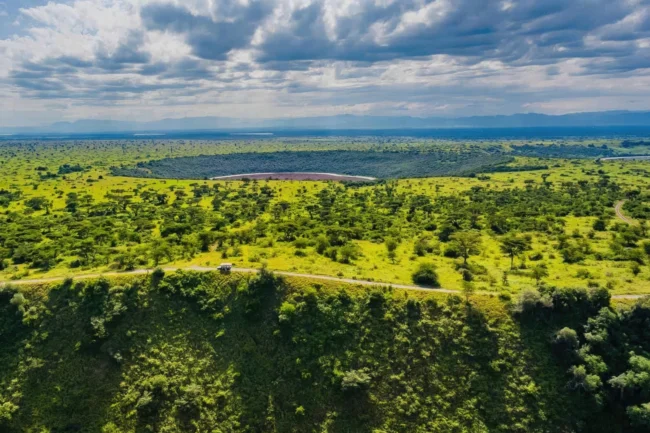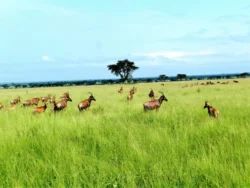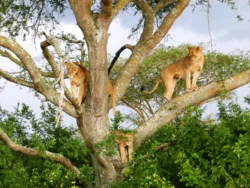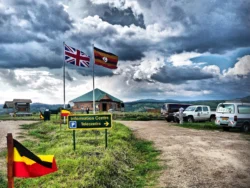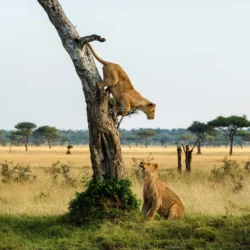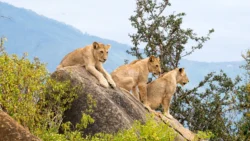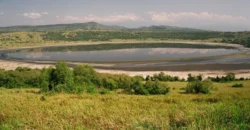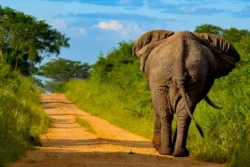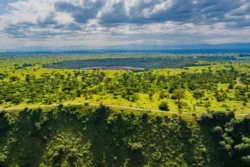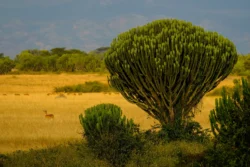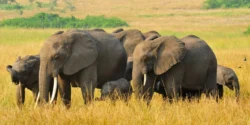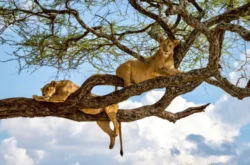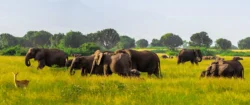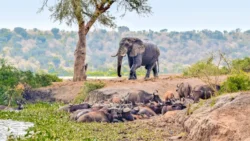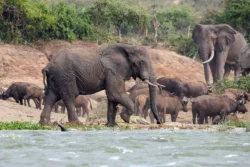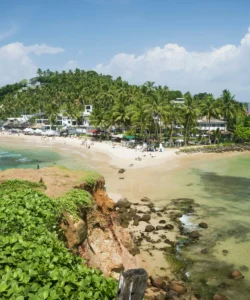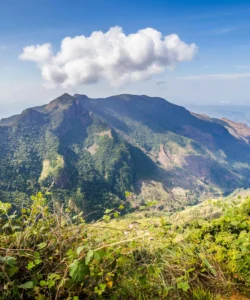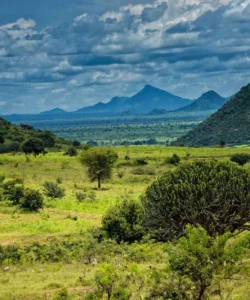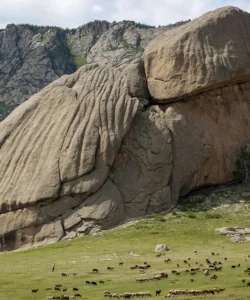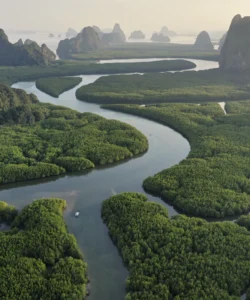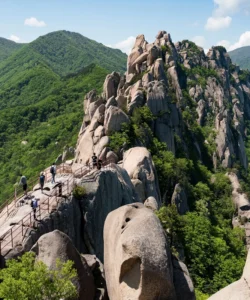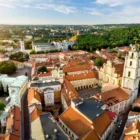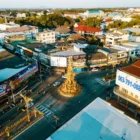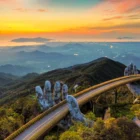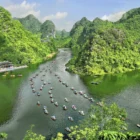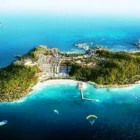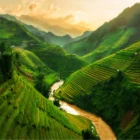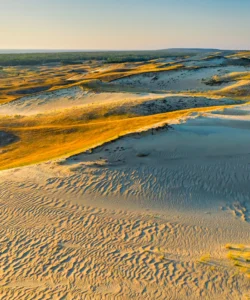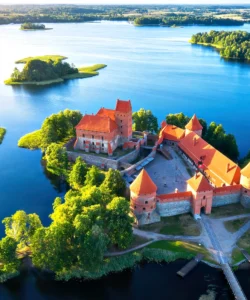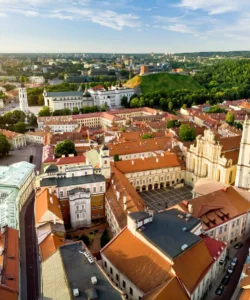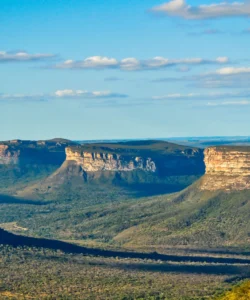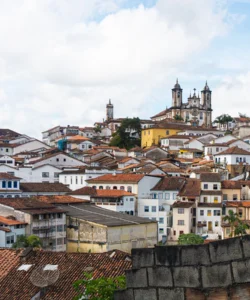Queen Elizabeth National Park (QENP) is Uganda’s most popular and biologically diverse national park, located in the western part of the country. Spanning nearly 2,000 square kilometers (764 sq miles), it is a tapestry of varied ecosystems, including expansive savannas, lush moist tropical forests, wetlands, and volcanic features. Named after Queen Elizabeth II of Britain following her visit in 1952, QENP offers a classic East African safari experience with an exceptional array of wildlife, unique behaviors like tree-climbing lions, and scenic landscapes that make it a premier destination for both big game viewing and birdwatching.
Name: Queen Elizabeth National Park (QENP)
Address: Western Uganda, straddling the districts of Kasese, Kamwenge, Rubirizi, and Rukungiri. It borders Virunga National Park in the Democratic Republic of Congo. The park headquarters are located at Mweya.
How to get there:
Reaching Queen Elizabeth National Park, requires significant international and domestic travel:
- From Entebbe/Kampala (Uganda) to Queen Elizabeth National Park:
- By Road (Most Common Safari Option): The park is approximately 370-420 km (230-260 miles) west of Kampala. The drive takes around 5-8 hours, depending on the specific route (via Mbarara to the eastern side or via Fort Portal to the northern side) and road conditions. Safari operators usually arrange pick-up from Entebbe/Kampala and all further transportation in a sturdy 4×4 safari vehicle as part of your package. The route via Fort Portal is often chosen if combining with Kibale National Park for chimpanzee trekking. There is also a route from the Buhoma sector of Bwindi Impenetrable National Park to QENP’s Ishasha sector (approx. 3 hours), popular for those combining gorilla trekking.
- By Air (Faster Option): Daily domestic flights depart from Entebbe International Airport or Kajjansi Airfield (near Kampala) to airstrips within or near the park.
- Kasese Airstrip: Located in the northern part of the park.
- Mweya Airstrip: Near the park headquarters and Kazinga Channel.
- Ishasha Airstrip: For those visiting the southern Ishasha sector.
Flights generally take 1-2 hours, followed by a 45-60 minute drive to the park.
Best Time to Visit:
Queen Elizabeth National Park is enjoyable year-round, but the dry seasons (January to February and June to September) are generally considered the best time for game drives and overall wildlife viewing. During these periods, vegetation is less dense, and animals congregate around water sources, making them easier to spot. Birdwatching is excellent between late May and September, when migratory birds are present. The wet seasons (March-May and October-November) offer lush green scenery and fewer tourists, but trails can be muddy.
Operating Hours and Entrance Fee:
- Operating Hours: The park is generally open daily from 6:00 AM to 7:00 PM. Game drives are typically done in the early morning or late afternoon.
- Entrance Fee (for Foreign Non-Residents):
- Adults: US$40 per person per day.
- Children (5-15 years): US$20 per person per day. (Children under 5 are exempt).
- Vehicles (4×4 safari vehicle): US$150 per vehicle per entry.
- Note: Fees are per 24 hours spent in the park and are subject to change by the Uganda Wildlife Authority (UWA). Separate fees apply for activities like boat cruises, chimpanzee trekking, and lion tracking.
Landscape and Architecture:
Queen Elizabeth National Park boasts an incredibly diverse landscape, influenced by its location within the Albertine Rift Valley:
- Kazinga Channel: This natural, 32-kilometer (20-mile) long channel connects Lake Edward and Lake George. It’s the park’s central aquatic feature, teeming with one of the world’s highest concentrations of hippos, as well as crocodiles, elephants, buffalo, and a vast array of water birds. Boat cruises along the channel are a major highlight.
- Savanna Grasslands: Extensive open grasslands dominate areas like the Kasenyi Plains and the Ishasha sector, providing excellent game viewing opportunities for lions, elephants, buffaloes, and various antelopes.
- Maramagambo Forest: A large, moist tropical forest in the park’s south, known for its chimpanzees, other primates, and birdlife. It also contains unique caves (like the Bat Cave, home to millions of bats, with pythons that prey on them).
- Volcanic Craters: The park features numerous volcanic craters, particularly the Katwe Explosion Craters in the north. Some are filled with water (crater lakes), some are salt lakes (like Lake Katwe, where salt is traditionally mined), and others are dry. This adds a unique geological dimension.
- Papyrus Swamps and Wetlands: Around the lakes and channels, vast papyrus swamps and wetlands provide crucial habitats for aquatic wildlife and birdlife, including the elusive shoebill stork.
- Ishasha Sector: Located in the remote southern part of the park, this sector is famous for its tree-climbing lions, a unique behavior where lions are seen lounging in large fig trees.
- Albertine Rift Valley Escarpment: The park sits on the floor of the rift valley, with escarpments creating dramatic views and varied microclimates.
- Safari Tracks and Basic Infrastructure: The park is traversed by unpaved game drive tracks. Accommodation within and around the park includes various lodges and tented camps, ranging from budget to luxury, designed to blend with the natural environment.
What makes it famous:
Queen Elizabeth National Park is famous for:
- Tree-Climbing Lions of Ishasha: This unique behavior, where lions regularly climb and rest in large fig trees, is a major draw and one of the park’s most iconic features.
- Kazinga Channel Boat Cruise: The unparalleled concentrations of hippos, buffaloes, elephants, and diverse birdlife along the Kazinga Channel, best viewed during a boat safari, are a world-class wildlife spectacle.
- High Biodiversity: It boasts the highest biodiversity of any protected area in Uganda, with over 95 mammal species (including four of the “Big Five” – lion, leopard, elephant, buffalo) and over 600 bird species, making it a top birding destination (ranked 2nd in Africa and 6th in the world for birding).
- Varied Ecosystems: Its diverse landscapes, from savannas and forests to lakes, rivers, and volcanic craters, offer a wide range of habitats and stunning scenery.
- Chimpanzee Tracking (Kyambura Gorge & Maramagambo Forest): The opportunity to track chimpanzees in the unique, forested Kyambura Gorge or Maramagambo Forest adds a primate tracking element to the classic safari experience.
- Cultural Experiences: Opportunities to engage with local communities involved in salt mining (Lake Katwe) or cultural performances.
- “Big Game” Viewing: Excellent sightings of elephants, buffaloes, Uganda kobs, topi, hippos, crocodiles, and often leopards and hyenas during game drives.
Differences from some other wonders:
Queen Elizabeth National Park distinguishes itself from other national parks and safari destinations in several key ways:
- Tree-Climbing Lions: While lions are found in many African parks, the consistent and widely observed behavior of tree-climbing lions in the Ishasha sector is unique to QENP (and a few other isolated locations globally). This specific behavior is a major draw and a key differentiator.
- Kazinga Channel’s Hippo Density: The unparalleled density of hippos and other aquatic wildlife along the Kazinga Channel boat cruise makes it a unique and world-class water safari experience, often exceeding what’s seen in other parks.
- Exceptional Bird Diversity: While many parks are good for birding, QENP’s record of over 600 bird species (almost 60% of Uganda’s total) within a single park makes it an exceptional destination specifically for birdwatchers.
- Volcanic Crater Landscape: The presence of numerous volcanic explosion craters and crater lakes (like the Katwe Craters) within its savanna and forest landscapes creates a distinct geological backdrop for wildlife viewing, unlike many purely grassland or bushveld parks.
- Combined Safari and Primates: QENP offers a unique blend of classic savanna game drives with the opportunity for chimpanzee trekking in the adjacent Kyambura Gorge or Maramagambo Forest, allowing for a broader primate and big game experience in one park.
- Connectivity to Gorilla Trekking: Its strategic location provides easy road access to Bwindi Impenetrable National Park for gorilla trekking, making it a natural and popular combination for a comprehensive Ugandan safari that covers both savanna wildlife and primates.
- More Diverse Ecosystems in One Park: Compared to some larger, more uniform savanna parks (e.g., Serengeti, Maasai Mara), QENP offers a remarkable variety of ecosystems – savanna, forest, wetlands, lakes, rivers, and volcanic features – packed into a relatively compact area.
In essence, Queen Elizabeth National Park is a vibrant and unique wonder, a true biodiversity hotspot that offers an exceptional combination of classic African safari experiences, peculiar wildlife behaviors like tree-climbing lions, stunning volcanic landscapes, and world-class birdwatching, all centered around the life-giving Kazinga Channel.
